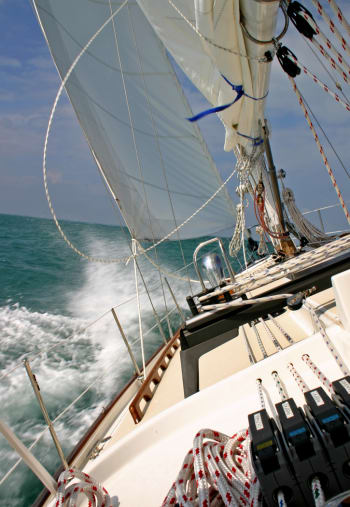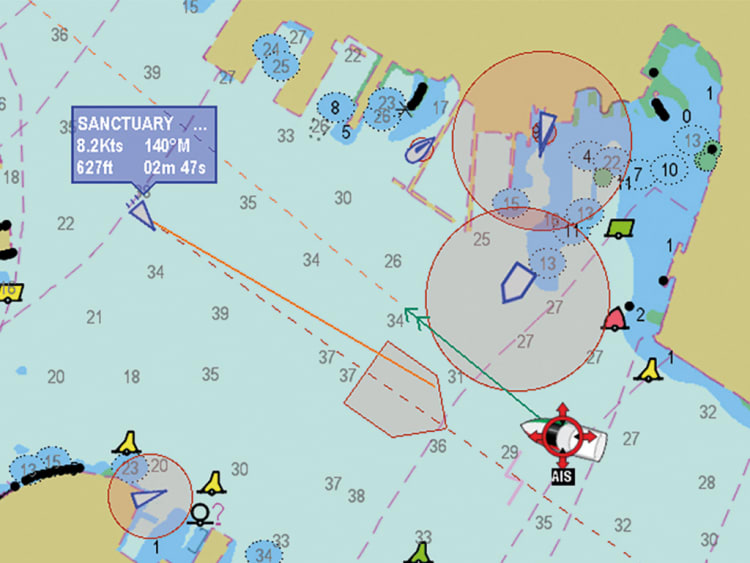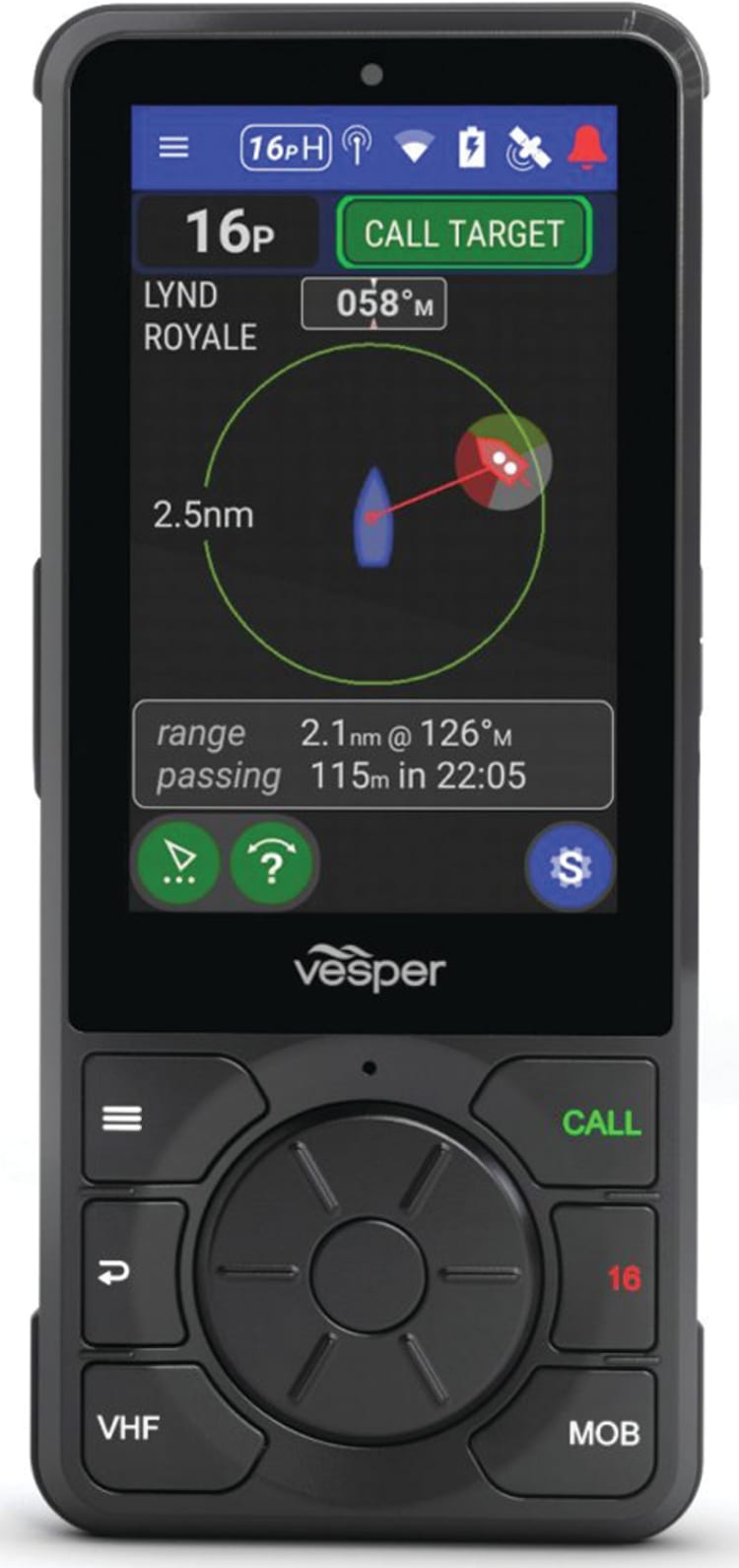Protect Your Boat with AIS

What if there was a technology out there that not only allowed you to immediately identify the name, course and speed of the boats around you – but also told you how close they will come to you and how much time you have to avoid them – would you buy it? That technology exists and it's called AIS (Automatic Identification System). With an AIS transceiver installed you can receive all that information overlaid right on your chart plotter – allowing you to simply click on each boat to view the information you need to avoid a collision. In this Navigator we will explore the pros and cons of the different type of AIS available, along with the equipment required for installation and some of the exciting new features offered by different manufacturers.
What Exactly is AIS?
Automatic Identification Systems (AIS) use VHF frequencies to transmit parcels of information to help vessels avoid collisions in boats that have been outfitted with its technology. When AIS is installed on a boat, the unit collects position and timing information of the boat from an external or integrated GPS receiver and then, using VHF, broadcasts out the location, vessel speed and course, vessel name and other bits of information to any other boats or land-based organizations in the vicinity that have an AIS receiver installed. Any boat with AIS can view the transmission on a screen, often overlaid on charting software, to easily see where other boats are in relation to their own location. AIS also provides valuable information about CPA (Closest Point of Approach) so that you'll know just how close that vessel will come to you if you both keep your current headings, along with TCPA – which is how much time you have before you reach that CPA. Information that once took complicated formulas with multiple measurements off a radar is now literally at our fingertips any time we want to take a look. Even better, AIS creates alarms to warn you when the TCPA is reaching a critical point and you are in immediate danger. AIS makes boating safer.
 The Classes of AIS:
The Classes of AIS:
When looking at AIS devices, you will notice that they are classified as either Class A, Class B+ or Class B. Before buying an AIS system, it is important to know which Class is appropriate for your boat.
Class A – Starting in 2002, Class A AIS units became required for all ships over 300 gross tons, and for all passenger ships regardless of size. These units transmit and receive information using SOTDMA (see below) which can transmit up to every 2-3 seconds and have sophisticated software that helps them determine when to transmit (and how often) based on whether the ship is moving or anchored. Class A units transmit at 12.5 watts, so can be received from up to 20-25 nautical miles away and will transmit more often the faster the vessel is moving. They are required to include an integrated display with keyboard and in addition to transmitting more frequently, then send considerably more information than a B or B+ unit.
Class B+ - Like the Class A, the newly designated "Class B+" transmits using SOTDMA – but only at 5 watts, so transmissions will be limited to approximately 10-12 nautical miles away. Also like Class A, the frequency of transmissions will be determined by how fast the vessel is moving – so the faster the speed, the more frequent the transmission along with guaranteed transmissions. For slow moving non-commercial vessels, this is not as important – but if you run your recreational boat at 20 knots or higher, you should seriously consider Class B+ over Class B.
Class B – These units are sold as receive only or as receive and transmit – using a CSTDMA transponder. These transponders transmit at just 2 watts – giving them a range of approximately 7-8 nautical miles – and send transmissions about every 30 seconds (assuming a slot is available). Class B devices are meant for recreational vessels that cruise at slower speeds. If your boat travels at a slow speed (e.g., less than 15 knots), a smaller transmission range and less frequent transmission rate is perfectly acceptable.
Receive Only – These units will only receive, read and display information about the vessels that are transmitting nearby. It will not transmit the location of the vessel it's on. Some recreational vessels have chosen this as an option as it gives excellent information while being slightly more economical.
 SOTDMA vs. CSTDMA
SOTDMA vs. CSTDMA
SOTDMA stands for Self-Organized Time Division Multiple Access. This technology allows up to 4500 ships to work in proximity of each other by figuring out which ships are in each other's path and giving them priority transmissions. Those ships that are moving faster can transmit more frequently than slower ships as the faster ship's position is changing quickly and so needs to be updated more often. SOTDMA transmissions are guaranteed and take place every 26.6 milliseconds – so there are usually more than enough transmission slots to safely report the location of all the vessels in the area. Both "A" and "B+" classes utilize SOTDMA technology.
CSTDMA stands for Carrier Sense Time Division Multiple Access. This technology listens for SOTDMA transmissions and grabs any empty time slots available in between those transmissions to transmit it's information. Class A and B+ transmissions will always have priority over any CSTDMA transmissions. While not guaranteed, with transmissions happening every 26.6 milliseconds there are usually plenty of slots to be had for all vessels in one location. CSTDMA units will only transmit approximately every 30 seconds – so if you have a very fast-moving vessel (over 20 knots), you should consider a Class B+ unit.
Because of these differences, the number of transmissions a vessel will make greatly depends on its class, whether it's anchored, underway or maneuvering. All Class A and B+ transmissions will take priority over class B transmissions. In addition, a fast-moving Class A vessel will transmit its position every couple of seconds. A Class B+ vessel moving at 20 knots may transmit every 7-10 seconds while a Class B recreational vessel will likely only transmit about every 30 seconds – and only if there is a time slot available. All of this basically combines to provide information to the vessels that are in the closest proximity and need it the most!
Why does the VHF Antenna Matter?
AIS transponders use a VHF antenna to make their transmissions – so the functions of AIS are only as good as the VHF antenna it's attached to. There are two options when installing AIS – one is to install a dedicated VHF antenna for the AIS unit, and the 2nd is to install a "low loss" splitter which allows you to use one VHF antenna for both your radio and AIS unit. Some newer units already come with a splitter installed, so it's important to understand what the unit comes with.
Why would you install two antennas when one will do? Because in a shared antenna environment the AIS will only transmit when the VHF radio is not in use – so if you are talking on the VHF, the AIS will not transmit. For the most part this situation will be fine – but in some situations, such as when there's a man overboard or a serious issue with an approaching boat, it may be VERY important that the AIS continues to transmit your location while you communicate with another vessel. If you only have one antenna, this can be dealt with by using a handheld VHF so that your AIS can still transmit. But you can avoid this issue altogether by installing a dedicated VHF antenna for each piece of equipment.
If you do decide to install a dedicated antenna for your AIS system, it's important to note that the antenna can NOT be located next to your radio antenna – so 2 antennas at the top of the mast is not a option. The AIS antenna needs to be located at least 4 feet away from any other VHF antenna and should be at least 10 feet above the water. Since the AIS transmissions are operating via VHF line-of-sight – the higher you locate the AIS antenna, the further you will be able to transmit and receive.
 Taking AIS to an Even Better Place
Taking AIS to an Even Better Place
While virtually ALL the well-known marine electronics manufacturers are now offering their own AIS transponders for recreational boaters, a couple manufacturers are taking AIS and its abilities to a whole new level. By utilizing NMEA connections, some brands such as Vesper Marine are creating devices that not only give you full AIS functionality, but also tie in other information offered by your electronics such as wind speed, water depth, GPS alarms for anchoring, battery monitoring and more. Add in a Wi-Fi connection and suddenly you can monitor these things from anywhere in the world – on or off your boat. With Vesper Marine's new Cortex system, you get a Class B+ transponder and a handheld VHF with a touchscreen monitor that not only displays targets and allows you to place DSC calls directly to any boat in the area with a touch of a button – but also allows you to connect any NMEA device onboard for easy monitoring. Connect it to Wi-Fi and you also get an anchor watch system for when you're away from the boat.

It's clear that the future holds exciting advances for the recreational boater – but one thing that cannot be denied is that if you can afford it, there's absolutely no reason to go without some sort of AIS transponder on your boat. AIS gives you clear information to help make informed and timely decisions in critical situations – making boating safer for everyone on the water.
We hope you've found this Navigator useful – but if you have additional questions, feel free to contact our product experts at (800) 426-6930.